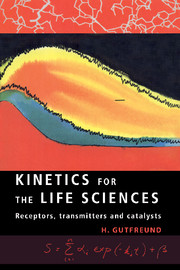Book contents
- Frontmatter
- Contents
- Preface
- 1 The time scales of nature: a historical survey
- 2 Some mathematical introductions
- 3 Elementary kinetic equations: ground rules
- 4 Kinetic analysis of complex reactions
- 5 Transient kinetics of enzyme reactions
- 6 Chemical relaxation phenomena
- 7 Factors affecting rates of reactions
- 8 The role of light in kinetic investigations
- References
- Index
2 - Some mathematical introductions
Published online by Cambridge University Press: 08 January 2010
- Frontmatter
- Contents
- Preface
- 1 The time scales of nature: a historical survey
- 2 Some mathematical introductions
- 3 Elementary kinetic equations: ground rules
- 4 Kinetic analysis of complex reactions
- 5 Transient kinetics of enzyme reactions
- 6 Chemical relaxation phenomena
- 7 Factors affecting rates of reactions
- 8 The role of light in kinetic investigations
- References
- Index
Summary
The origins of exponential behaviour
Mathematics as the language for kinetics
Some topics covered in this volume are more easily described by mathematical equations than by words, while others can only be described in algebraic language. An attempt is made in this chapter to state the mathematical principles which are the foundation of kinetic behaviour and to present the methods used to derive the equations which describe this behaviour. It is not essential to understand the contents of this chapter to benefit from the rest of this volume, but it is difficult to avoid mistakes in kinetic investigations without it.
It will be seen that exponential curves of one sort or another crop up everywhere in the study of the rates of reactions. Not only is the change of concentration (or membrane current, etc.) frequently described by an exponential function of time (or by the sum of several such functions), but exponentials also appear in some of the more exotic ways of measuring rates, such as in the study of fluctuations and noise. Furthermore the study of individual molecules, as is possible for some sorts of ion channel, gives rise to probability distributions (e.g. the distribution of the length of time for which an individual channel stays open) that are also described by exponentials (Colquhoun & Hawkes, 1983). Unfortunately some of these topics can only be referred to in passing in the present volume. It is, however, important to realize that it is sometimes useful to distinguish between the lifetime of a state (or reaction intermediate) and the rate (or probability) of its decay.
- Type
- Chapter
- Information
- Kinetics for the Life SciencesReceptors, Transmitters and Catalysts, pp. 19 - 44Publisher: Cambridge University PressPrint publication year: 1995



